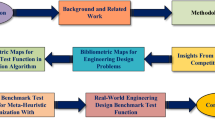Abstract
Interval-based branch & bound solvers are commonly used for solving Nonlinear Continuous global Optimization Problems (NCOPs). In each iteration, the solver strategically chooses and processes a node within the search tree. The node is bisected and the two generated offspring nodes are processed by filtering methods. For each of these nodes, the solver also searches for new feasible solutions in order to update the best candidate solution. The cost of this solution is used for pruning non-optimal branches of the search tree. Thus, node selection and finding new solutions, stands as pivotal aspects in the functionality of these kind of solvers. The ability to find close-to-optimal solutions early in the search process may discard extensive non-optimal search space regions, thereby effectively reducing the overall size of the search tree. In this work, we propose three novel node selection algorithms that use the feasible solutions obtained through a cost-effective iterative method. Upon updating the best candidate solution, these algorithms strategically choose the node containing this solution for subsequent processing. The newly introduced strategies have been incorporated as node selection methods in a state-of-the-art branch & bound solver, showing promising results in a set of 57 benchmark instances.

Similar content being viewed by others
Notes
An interval \(\varvec{x}_i=[\underline{x_i},\overline{x_i}]\) defines the set of reals \(x_i\), such that \(\underline{x_i} \le x_i \le \overline{x_i}\). A box \(\varvec{x}\) is a Cartesian product of intervals \(\varvec{x}_1 \times .. \times \varvec{x}_i \times ... \times \varvec{x}_n\).
References
Lebbah, Y.: Icos: a branch and bound based solver for rigorous global optimization. Optim. Methods Softw. 24(4–5), 709–726 (2009)
Neveu, B., Trombettoni, G., Araya, I.: Node selection heuristics using the upper bound in interval branch and bound, In: Proceedings of GOW, pp. 1–4, (2014)
Neveu, B., Trombettoni, G., Araya, I.: Node selection strategies in interval branch and bound algorithms. J. Global Optim. 64, 289–304 (2016)
Markót, M.C., Fernández, J., Casado, L.G., Csendes, T.: New interval methods for constrained global optimization. Math. Program. 106, 287–318 (2006)
Araya, I., Neveu, B.: lsmear: a variable selection strategy for interval branch and bound solvers. J. Glob. Optim. 71(3), 483–500 (2017)
Trombettoni, G., Chabert, G.: Constructive interval disjunction. In: Principles and Practice of Constraint Programming-CP, pp. 635–650. Springer, Berlin (2007)
Araya, I., Trombettoni, G., Neveu, B.: A contractor based on convex interval taylor. In: Integration of AI and OR Techniques in Contraint Programming for Combinatorial Optimzation Problems, pp. 1–16. Springer, Berlin (2012)
Ninin, J., Messine, F., Hansen, P.: A reliable affine relaxation method for global optimization. 4OR 13(3), 247–277 (2015)
Goldsztejn, A., Lebbah, Y., Michel, C., Rueher, M.: Revisiting the upper bounding process in a safe branch and bound algorithm, In: International Conference on Principles and Practice of Constraint Programming, pp. 598–602, Springer, (2008)
Misener, R., Floudas, C.A.: Antigone: algorithms for continuous/integer global optimization of nonlinear equations. J. Glob. Optim. 59(2), 503–526 (2013)
Sahinidis, N.V.: Baron: a general purpose global optimization software package. J. Glob. Optim. 8(2), 201–205 (1996)
Drud, A.S.: CONOPT-a large-scale GRG code. ORSA J. Comput. 6(2), 207–216 (1994)
Wächter, A., Biegler, L.T.: On the implementation of an interior-point filter line-search algorithm for large-scale nonlinear programming. Math. Program. 106(1), 25–57 (2006)
Araya, I., Trombettoni, G., Neveu, B., Chabert, G.: Upper bounding in inner regions for global optimization under inequality constraints. J. Global Optim. 60(2), 145–164 (2014)
Araya, I., Reyes, V. Abstaylor: finding inner regions for nonlinear constraint systems with linearizations and absolute values, In: AIP Conference Proceedings, vol. 2070, p. 020027. AIP Publishing LLC, (2019)
Reyes, V., Araya, I.: Abstaylor: upper bounding with inner regions in nonlinear continuous global optimization problems. J. Glob. Optim. 79(2), 413–429 (2021)
Bixby, R., Rothberg, E.: Progress in computational mixed integer programming-a look back from the other side of the tipping point. Ann. Oper. Res. 149(1), 37 (2007)
Bonami, P., Kilinç, M., Linderoth, J.: Algorithms and software for convex mixed integer nonlinear programs. In: De, T. (ed.) Mixed Integer Nonlinear Programming, pp. 1–39. Springer, Berlin (2011)
Khajavirad, A., Sahinidis, N.V.: A hybrid LP/NLP paradigm for global optimization relaxations. Math. Program. Comput. 10(3), 383–421 (2018)
Lasdon, L.S., Waren, A.D., Jain, A., Ratner, M.: Design and testing of a generalized reduced gradient code for nonlinear programming, Technical. Report, Stanford University CA Systems Optimization Laboratory (1976)
Wright, S.J.: Primal-Dual Interior-Point Methods, vol. 54. SIAM, New Delhi (1997)
Nocedal, J., Wächter, A., Waltz, R.A.: Adaptive barrier update strategies for nonlinear interior methods. SIAM J. Optim. 19(4), 1674–1693 (2009)
Klee, V., Minty, G.J.: How good is the simplex algorithm. Inequalities 3(3), 159–175 (1972)
Trombettoni, G., Araya,I., Neveu,B., Chabert, G.: Inner regions and interval linearizations for global optimization. In: AAAI Conference on Artificial Intelligence (2011)
Benhamou, F., Goualard, F., Granvilliers,L., Puget, J.-F.: Revising hull and box consistency, In: International Conference on Logic Programming, Citeseer, (1999)
Acknowledgements
Victor Reyes is supported by Fondecyt Project 11230225. Ignacio Araya is supported by Fondecyt Project 1200035.
Author information
Authors and Affiliations
Corresponding author
Ethics declarations
Conflict of interest
The authors declare that they have no Conflict of interest.
Additional information
Publisher's Note
Springer Nature remains neutral with regard to jurisdictional claims in published maps and institutional affiliations.
Rights and permissions
Springer Nature or its licensor (e.g. a society or other partner) holds exclusive rights to this article under a publishing agreement with the author(s) or other rightsholder(s); author self-archiving of the accepted manuscript version of this article is solely governed by the terms of such publishing agreement and applicable law.
About this article
Cite this article
Reyes, V., Araya, I. Node selection through upper bounding local search methods in branch & bound solvers for NCOPs. J Glob Optim (2024). https://doi.org/10.1007/s10898-024-01403-2
Received:
Accepted:
Published:
DOI: https://doi.org/10.1007/s10898-024-01403-2




